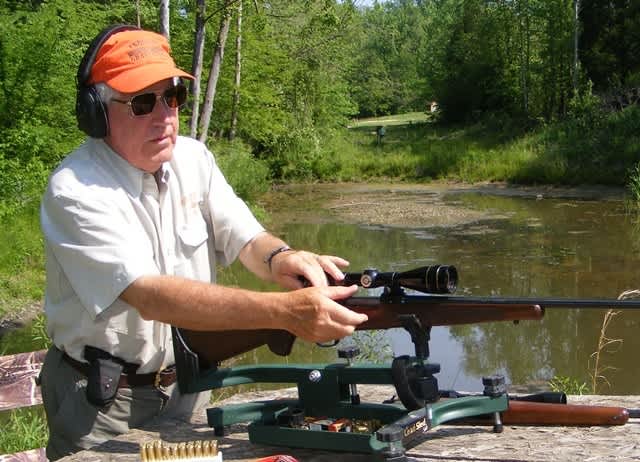Parallax: The Mystery Adjustment
Lewis Creek Shooting School 08.22.12

My TV remote, video camera, and cell phone have numerous buttons that do all kinds of things with unknown consequences and I stay away from them. Sometimes I accidentally hit one and I have to have one of the grandkids over to correct the problem. The cost is small, maybe an ice cream cone or cookie, but setting the parallax setting on your scope wrong could cost you the trophy of a lifetime.
In a way, most of us treat the parallax adjustment on our rifle scope the same way as those strange buttons on the TV remote. In fact, the function of that adjustment seems to confuse even the marketing folks and those who write the manuals. I looked at a standard of the industry scope this week and the parallax adjustment knob was labeled ‘’Focus”. While the knob will focus the scope, its main function is to improve the accuracy of the scope at a specific range. The adjustment of the ocular lens on the rear of the scope provides focus.
The ocular lens (the one next to your eye) on most scopes provides an adjustment to clear the crosshairs and provide a clear view of the target. The parallax adjustment (normally on the objective lens or a knob opposite the windage knob) is to allow you to set the scope so the crosshairs consistently intersect on the same point at a specific range regardless of where your put your head on the stock.
Since scopes bend light to achieve magnification, there’s potential for the reticle to move across the target when the shooter’s eye moves behind the scope. Obviously, this would cause inaccuracy if the shooter didn’t place his head in exactly the same place for each shot. External parallax adjustments allow the shooter to remove this error at a given range. Scopes without external adjustments normally come set for 100 yards for centerfire scopes and 50 yards for rimfire scopes. Parallax adjustment is much more critical at closer ranges. This is why quality airgun scopes always have adjustable parallax.
The parallax setting on your scope affects focus but it’s not the primary method for focusing the scope. Once the focus is properly set, the parallax adjustment will focus the scope and reduce the parallax problem but, for the best accuracy, you should check for more than just focus. Many shooters simply set the adjustment according to the scale provided for that range. This is rarely the optimum setting and can enlarge groups considerably. To properly set the parallax setting on your scope for a specific distance, first put the rifle in a cradle or mount, like a Lead Sled. I use the Lead Sled for sighting in, cleaning and maintenance; I can’t imagine life without one. Next, focus the ocular lens, the lens closest to your eye. I like to do this with the scope looking at a target a known distance away and the parallax setting set on that distance, provided the scope’s adjustment shows distance settings. Adjust the ocular lens until the target and crosshairs are in sharp focus. There is some latitude in this because your eye also contributes to the process.
Once focused, move your eye across the ocular lens as far as you can while still getting a full field of view. If the reticle moves, try adjusting the ocular lens within the comfort level of your eye. Subtle parallax adjustments can be achieved this way and the process will make the distance scale on the adjustment knob more accurate. If you can’t achieve a zero parallax condition this way, you’ll have to move the knob to get there. With the parallax properly set, the reticle will not move at all when you move your head. Remember that during this movement, you cannot be touching the rifle at all and it must be stable. Bracing on the bench will cause movement you might mistake for parallax and you’ll never get there. Once properly adjusted, the reticle and field of vision will be clear and in focus and the reticle will not move across the target when you move your head behind the scope. With the parallax properly set, the reticle will not move no matter where your head is on the stock.
All this might seem complicated in description but it’s really not difficult, once you have the concept. The result is a big reward in improved accuracy and confidence and whether you’re on the range shooting for a trophy or lining up on a trophy animal, confidence is a priceless asset.

